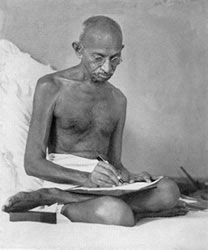
P.O. SEVAGRAM, DIST.WARDHA 442102, MS, INDIA. Phone: 91-7152-284753
FOUNDED BY MAHATMA GANDHI IN 1936
Short Stories For Everyone
Inspiring incidents from Gandhiji's Life: Selected from the book Everyone's Gandhi
(For the children in the age group of 10 to 15 years)

SHORT STORIES FOR EVERYONE
Gandhi's inspiring short stories selected from the book Everyone's Gandhi
Editor by : Rita Roy
Table of Contents
- All for A Stone
- A Car And A Pair of Binoculars
- My Master's Master
- Enter The Monkeys
- Premchand Quits His Job
- Returning His Medals
- Basic Pen
- Prisoner No. 1739
- Gandhi's White Brother
- Who Saw Gandhi?
- An Early School
- An Unusual March
- Spiritual Heir
- The Less You Have The More You Are
- An Old Goat Talks
- The Phoenix Settlement
- Gandhi in Amsterdam
- Something To Be Shy About?
- Gandhiji The Matchmaker
- Gandhi's Army
- Dandi Snippet
- Hiding Something
- The Image Maker
- Creative Reader
- Postcards To The Rescue
- A Non-violent Satyagraha 214 Years Ago
- Gandhi And Delhi
- Gandhiji's Constructive Programme
- Gandhi Looks At Leprosy
- Baba Amte
- They Gave Peace A Chance
- From Mahatma To God
- Customs Are Out of Fashion
- The Man 'Charlie' Wanted To Meet
- It Came Naturally To Him
- Crossing The Sea of Narrow-Mindedness
- Wear Clothes As They Should Be Worn
- Education: For Life, Through Life
- The Abode of Joy
- To Cling to A Belief
- The Fruit of A Child's Labour
- An Ideal Prisoner
- How A Film Became Something More
- Gandhi: Beyond India
- Gandhi's Life-Saving Medicine
- Understanding The Mechanics of Life With Gandhi
- The Lokmanya and The Mahatma
- Man's Gift To Nature
- Gurudev And His Mahatma
- One-man Boundary Force
- What Does Mahatma Gandhi's Message Mean To Me?
- Let's Play Together
- Children's Response To Conflict
- Beggar By Choice
- The Better Half
- Uncle Gandhi
- The Watch: An Instrument For Regulating Life
- Light The Lamp of Your Mind
- Gandhi's Bet!
- Gandhi Feeling At Home In The Kitchen
- What Is Simplicity?
- Bapu And The Sardar
- The Power of Quality
- Gandhi: The Teenager!
Chapter 17: Gandhi At A School In Amsterdam
Piet Dijkstra
Far from India lies Amsterdam a major city of the Netherlands. How far do you think is Amsterdam? Well, if a cyclist were to travel a hundred kilometers a day and follow a straight route, it would take her a little over 10 weeks!
In this far-away city is a school where children have 'adopted' Gandhi. This is how their teacher describes their relationship.
In front of me sit some forty children, all from the higher grades of a primary school in Amsterdam. Half of them are Dutch, the other half is of various descent -- some from North Africa (mostly Morocco or Turkey) but the majority from Surinam, a former Dutch colony in the West Indies. Their grandfathers or great-grandfathers had come as contract or even bonded labour from certain areas in India or the former Dutch East Indies to work on Surinamese sugar plantations. In fact, many of their parents still speak Hindi, though the children speak Dutch at school.
The whole class knows about Gandhi. Just a few hundred metres away stands the Gandhi Monument. Some five years ago, people from Surinam took the initiative to establish and inaugurate this monument. And it is this school that has adopted the Gandhi Monument.
Adoption in this case means that the pupils of the school have the task of keeping clean the pedestal of the statue and the cobbles around the monument. Of course, the municipality gives them the material for this. The cleaning is done at regular intervals and, in particular, before the commemoration of Gandhi's birthday on 2nd October.
While Gandhi is not unknown to them, before the 2nd October the children always request to have specific lessons on Gandhi at school. India and Gandhi are at the centre of their interest then.
Compared with Holland, India is an enormous country. We start therefore with a lesson on geography of India. When a map of India is placed on a map of Europe, we find that the Himalayas fall on the North Of Norway while the South of India lies in the Mediterranean! Every year, almost the same number of children are born in India as there are people living in the Netherlands.
A great difference with India is its many languages. The children certainly will all know about the differences in religion: some go to mosques, others to temples or churches. From here, we move on to talk about their relationships. Why do they look different and why are they equals? Is it nice to be different or should there be no difference?
The lesson on Gandhi then starts with a brief video on his work and his activities. Of course he is the Father of the Indian Nation. But more important is what he did on relations between human beings. We tie in with children's own experiences and what they feel about others. Do they fight now and then? Do they call names and why? Is it right to behave in a violent way?
A few of the children have heard about nonviolence from their parents at home. We go a step forward, talking about how much nicer it might be to cooperate with each other than to fight. It is explained how Gandhi wanted to raise the self-esteem of every Indian individually and of the Indian nation as a whole. How he tried to improve relations between the various communities in India and how he gave an example himself. And finally, what could they do themselves so that persons of various descent, creed and colour can live together without acting against each other in a violent way?